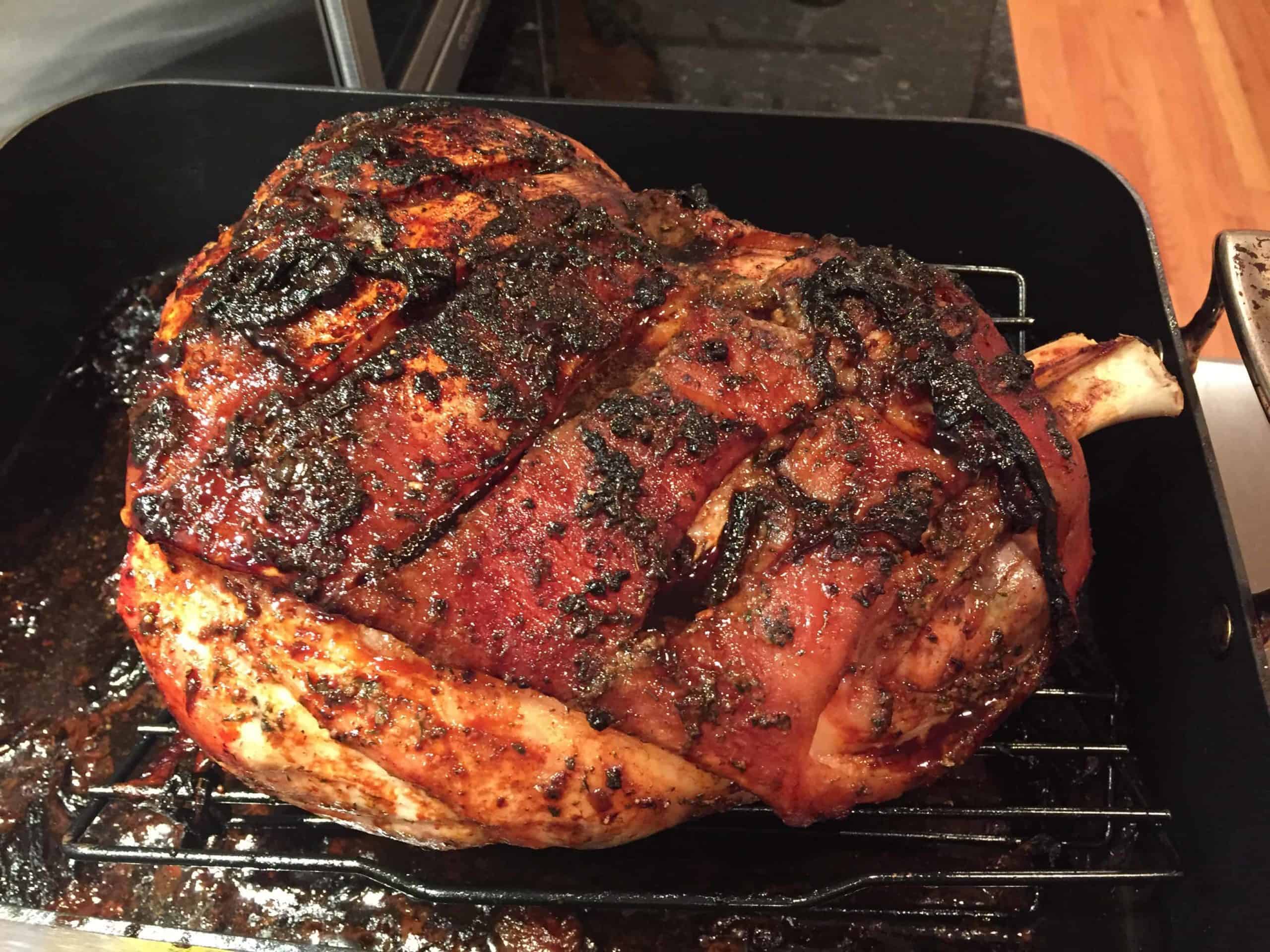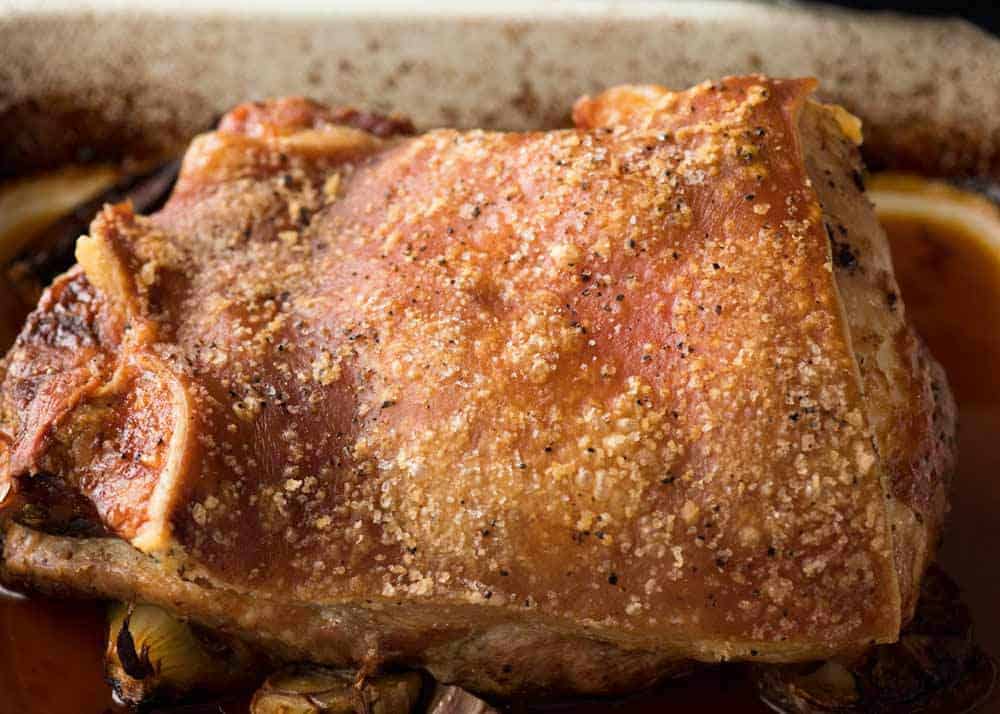Here it is: the best pork roast ever, with very tender meat and very crispy pork crackling! To make the pork crackling really crispy, this pork shoulder roast uses a simple but very effective method. Every. Single. Time. And without scoring the skin!.
This is The Roast Recipe I use, and it’s always a hit. I serve it with homemade pork gravy.
Pork shoulder is a flavorful, inexpensive cut that’s ideal for slow cooking. But the skin can sometimes be confusing. Should you leave it on or take it off? And if you remove it, what can you do with that crispy, fatty skin? This guide covers everything you need to know about getting the most out of pork shoulder skin.
The Case for Leaving It On
There are some good reasons to leave the skin on your pork shoulder before cooking
-
It protects the meat and keeps it tender and juicy during slow roasting or braising. The fat layer insulates the meat.
-
Skin left on infuses flavor into the pork as it cooks down All that collagen and fat equals tons of taste!
-
The skin gives you the option of getting crackly, crunchy texture on part of the shoulder. Especially delicious on carnitas tacos or fried rice.
-
When roasted low and slow, the skin helps autogenerate moisture and texture. No need to constantly baste.
So if you want succulent pulled pork or are planning to crisp up the skin after cooking leave that skin right where it is!
The Case for Taking It Off
However, there are also solid reasons to remove pork shoulder skin prior to cooking:
-
It allows rubs and sauces to better penetrate the meat. Skin can create a barrier to flavors permeating.
-
Skinless cooking gives more even spice coverage. Skin on, seasoning usually only affects the very outer layer.
-
Without skin, overall texture is more consistently tender. No chewy bits of unrendered skin.
-
It reduces overall fat and calorie content. Skin accounts for a significant portion of pork fat.
-
Skinless is easier for shredding pork and getting the consistency you want.
So if you’re watching fat intake or want meat that’s fully infused with seasoning, skin off may be the better choice.
How to Remove the Skin
Removing skin is easy with a sharp boning knife or kitchen shears. Simply slice under one edge of skin and then pull it off, using the knife to assist as needed.
For the best of both worlds, you can score the skin before cooking – this allows seasonings to penetrate but leaves some skin for moisture and texture.
Save any removed skin for making snacks like chicharrones or flavoring beans and stews. It freezes well too.
What to Do With Removed Pork Skin
Now that big question – what can you do with pork skin once it’s removed? Here are some delicious ideas:
Make Chicharrones or Pork Rinds
Cut the skin into 1-inch pieces, fry in oil at 350°F until puffed and crispy, and season with salt, spices, or lime. Irresistible!
Use as Flavoring for Beans or Stew
Simmer skin in beans, chili, or soup to impart rich pork taste. Collagen adds body too. Remove before serving.
Make Homemade Lard
Rendered pork fat has endless uses. Great for pie crusts, frying, refried beans, and more. Store in the fridge or freezer.
Create Silky Sauces
Simmer skin scraps in milk or stock, then puree into a smooth sauce. The natural gelatin gives amazing texture.
Craft Dog Treats
Dry leftover bits of skin, then bake into natural jerky-style treats. Pork skin is safe for dogs and provides protein.
Prepare Filipino Sisig
This traditional dish features crispy pig head skin. Shoulder skin works too! Season, crisp, then mix with citrus and chili.
As you can see, pork skin is very versatile. Whether you leave it on, take it off, or both – make the most of this often forgotten part of the pig!
Delicious Skin-On Pork Shoulder Recipes
Want to enjoy tender, juicy pork bathed in crisp, fatty skin? Try these mouthwatering skin-on pork shoulder recipes:
Slow Roasted Pork Shoulder
Coat with spices and roast 4-6 hours at 300°F until falling apart tender. Broil skin at end to crispen.
Chipotle Pulled Pork
Infuse pork with smoky chipotle in adobo. Shred meat and mix with cooking juices for tacos or sandwiches.
Carnitas
Cook seasoned pork in lard or oil until tender. Fry shredded meat in its own fat until crispy.
Lu Rou Fan
Braise Chinese five spice seasoned pork in soy sauce and rice wine. Serve over rice with crispy skin on top.
Pork Rillettes
Cook pork in fat until spreadably tender. Shred meat, mix with some of the fat, and enjoy on crusty bread.
The possibilities are endless for preparing fork-tender pork shoulder capped with crunchy, porky skin. Now go get cooking!
No Skin? No Problem! Skinless Pork Recipes
If you prefer to remove the skin, don’t worry – the pork will still be full of flavor. Try recipes like:
Chile Verde
Braise pork in tangy green salsa until falling apart. Shred and serve in tortillas or over rice.
Pineapple Pork Roast
Stud roast with garlic and roast with pineapple chunks and juice. Falls off the bone tender.
Thai Red Curry
Simmer pork in coconut milk with red curry paste and vegetables. Ladle over jasmine rice.
Mediterranean Pork and Orzo
Braise pork with tomatoes, olives, and spices. Toss with orzo pasta for a one-pot meal.
Pork Chile Colorado
Slow cook pork in ancho chili sauce until shreddable. Top with cilantro and onion.
See? You don’t need the skin to end up with mouthwatering pulled pork for tacos, stirring into pasta, topping pizza, and more! Get creative with the flavors.
Final Thoughts
The pork shoulder skin decision ultimately comes down to your recipe, preferences, and goals:
-
Skin on = moisture protection and crispy exterior
-
Skin off = better seasoning infusion and texture
-
Scored skin = best of both!
Whichever you choose, remember to save skin for cracklings, lard, or flavor. With proper methods, pork shoulder skin can take your dishes to the next level of finger-licking, lip-smacking deliciousness.

Low heat then high heat
For juicy, slow-cooked meat, you need to cook it slowly for a long time at a lower temperature. For crispy crackling, you need to cook it over very high heat.
So we start this pork on a lower temperature for 2. 5 hours to cook and break down the tough meat to make it beautifully juicy. This is less time than other recipes you may see because it’s a boneless pork shoulder.
This is what the pork looks like partway through roasting, before crisping up the crackling:

Pork roast cooking time
For 2 1/2 hours, roast at 160°C/320°F (140°C fan) to make the meat soft and juicy. Then, roast at 250°C/485°F for 30 minutes to make the skin crispy.
Keep in mind that this pork roast was slowly cooked, so the meat is almost fall-apart tender (like Pulled Pork), but not quite. You can still carve it like you would with a regular pork roast.
CRISPY ROAST PORK SHOULDER RECIPE WITH SKIN (CRACKLING) AND HOMEMADE GRAVY
FAQ
What do I do with the skin on a pork shoulder?
What to do with pulled pork skin?
What can I do with pork shoulder fat?
How to crisp up pork shoulder skin?
How do you cook a pork shoulder with a dry skin?
KEY STEPS: Use pork shoulder, dry skin, no need to score (but if it’s already scored, that’s ok), salt the skin evenly, slow roast low uncovered, keep the skin surface level using foil balls, and blast it for crispy skin! Read the post for extra tips, step photos, and why this recipe works! Dry skin: Pat the skin dry with paper towels.
Can you use pork shoulder instead of pork shoulder?
As a bonus, your total meat yield will be higher, and you’ll have less waste to deal with afterward. Pork butt is usually the better choice when making pulled pork. You can use pork shoulder instead, but if you do, it’s best to remove the skin beforehand. Why? Because the skin will prevent the seasoning rub from permeating the meat itself.
How do you cut a pork shoulder?
Turn the pork shoulder on its side and slide the knife under one edge of the skin. Cut along the length of the pork shoulder, pulling the skin away as you go. The job is easier if you have a sturdy pair of kitchen scissors. If you leave some of the skin in place, it can help to flavor the meat as it cooks.
Should you leave skin on pork shoulder?
Whether or not you leave the skin on the pork shoulder depends on what you plan to do with it. For pulled pork, it’s a good idea to remove most of the skin. For other dishes that would benefit from the crispy texture, though, you should leave it in place. Pork Butt vs Pork Shoulder: What’s the Difference?
